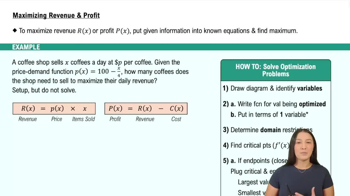Table of contents
- 0. Functions7h 52m
- Introduction to Functions16m
- Piecewise Functions10m
- Properties of Functions9m
- Common Functions1h 8m
- Transformations5m
- Combining Functions27m
- Exponent rules32m
- Exponential Functions28m
- Logarithmic Functions24m
- Properties of Logarithms34m
- Exponential & Logarithmic Equations35m
- Introduction to Trigonometric Functions38m
- Graphs of Trigonometric Functions44m
- Trigonometric Identities47m
- Inverse Trigonometric Functions48m
- 1. Limits and Continuity2h 2m
- 2. Intro to Derivatives1h 33m
- 3. Techniques of Differentiation3h 18m
- 4. Applications of Derivatives2h 38m
- 5. Graphical Applications of Derivatives6h 2m
- 6. Derivatives of Inverse, Exponential, & Logarithmic Functions2h 37m
- 7. Antiderivatives & Indefinite Integrals1h 26m
- 8. Definite Integrals4h 44m
- 9. Graphical Applications of Integrals2h 27m
- 10. Physics Applications of Integrals 2h 22m
5. Graphical Applications of Derivatives
Applied Optimization
Problem 4.5.36
Textbook Question
Covering a marble Imagine a flat-bottomed cylindrical pot with a circular cross section of radius 4. A marble with radius 0 < r < 4 is placed in the bottom of the pot. What is the radius of the marble that requires the most water to cover it completely?
 Verified step by step guidance
Verified step by step guidance1
Understand the problem: We need to find the radius of the marble that requires the most water to cover it completely when placed at the bottom of a cylindrical pot with a radius of 4.
Visualize the situation: The marble is a sphere with radius r, and it is placed at the bottom of the cylinder. The water will form a spherical cap over the marble.
Determine the volume of water needed: The volume of water required to cover the marble is the volume of the spherical cap. The formula for the volume of a spherical cap is \( V = \frac{1}{3} \pi h^2 (3R - h) \), where h is the height of the cap and R is the radius of the sphere.
Relate the height of the cap to the radius of the marble: The height h of the cap is related to the radius of the marble r by the formula \( h = R - \sqrt{R^2 - r^2} \). Substitute this into the volume formula.
Maximize the volume: To find the radius r that requires the most water, take the derivative of the volume with respect to r, set it equal to zero, and solve for r. This will give the critical points, and you can determine which one maximizes the volume.
 Verified video answer for a similar problem:
Verified video answer for a similar problem:This video solution was recommended by our tutors as helpful for the problem above
Video duration:
6mPlay a video:
Was this helpful?
Key Concepts
Here are the essential concepts you must grasp in order to answer the question correctly.
Volume of a Cylinder
The volume of a cylinder is calculated using the formula V = πr²h, where r is the radius of the base and h is the height. In this context, the cylindrical pot's volume will help determine how much water is needed to cover the marble. Understanding this formula is essential for calculating the water volume required based on the marble's radius.
Recommended video:

Example 5: Packaging Design
Volume of a Sphere
The volume of a sphere is given by the formula V = (4/3)πr³, where r is the radius of the sphere. This concept is crucial for determining the volume of the marble, which directly affects how much water is needed to cover it. Knowing how to apply this formula allows for the calculation of the marble's volume based on its radius.
Recommended video:

Example 5: Packaging Design
Optimization
Optimization in calculus involves finding the maximum or minimum values of a function. In this problem, we need to determine the radius of the marble that maximizes the volume of water needed to cover it. This requires setting up a function that relates the marble's radius to the water volume and using techniques such as differentiation to find the optimal radius.
Recommended video:

Intro to Applied Optimization: Maximizing Area

 1:13m
1:13mWatch next
Master Intro to Applied Optimization: Maximizing Area with a bite sized video explanation from Callie
Start learningRelated Videos
Related Practice







